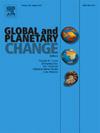1.6 Ma biostratigraphy, oxygen isotope record and paleoceanography of the IODP 353 Site U1443 in the equatorial eastern Indian Ocean
IF 4
1区 地球科学
Q1 GEOGRAPHY, PHYSICAL
引用次数: 0
Abstract
Paleoceanographic studies rely heavily on an accurate stratigraphy as well as the interpretation of the oxygen isotope (δ18O) records generated from microfossils. In this study, we present new planktonic foraminiferal assemblage and stable oxygen isotope records of both planktonic and benthic foraminifera from sedimentary deposits at the IODP Site U1443 on the northern Ninety East Ridge in the equatorial eastern Indian Ocean. Five planktonic foraminiferal datums were identified, which allowed us to refine the Pleistocene biostratigraphical sequence of the site. Our benthic δ18O record was tuned to that of the LR04 stack with consideration of the planktonic foraminifera and nannofossil datums, volcanic ash, and geomagnetic reversal events. This led to a refined stratigraphic framework for 1.6 Ma at the IODP Site U1443. We focus our discussion on the paleoceanographic and paleoclimatic interpretations of the newly obtained δ18O records. The synchronous variations of the U1443 planktonic δ18O record with the obliquity fluctuations during the 1.6 Ma – 0.8 Ma point to the presence of a signal of high-latitude insolation in the surface waters of the study area. By contrast, from 0.8 Ma, the δ18O record exhibits distinct precession signal, as observed in the South China Sea, which we interpret as being influenced by regional hydroclimate dynamics, such as monsoons. This study therefore provides new data for investigating possible mechanisms that link the high and low latitudes into the early Pleistocene.
赤道东印度洋 IODP 353 站点 U1443 的 1.6 Ma 生物地层学、氧同位素记录和古海洋学
古海洋学研究在很大程度上依赖于准确的地层学以及对微小化石生成的氧同位素(δ18O)记录的解释。在本研究中,我们展示了赤道东印度洋九十东海脊北部 IODP U1443 号站点沉积物中浮游有孔虫和底栖有孔虫的新浮游有孔虫组合和稳定氧同位素记录。我们确定了五个浮游有孔虫标本,从而完善了该地点的更新世生物地层序列。考虑到浮游有孔虫和化石基准、火山灰和地磁反转事件,我们将底栖生物的δ18O记录调整为 LR04 叠层的记录。这样,IODP U1443地点的1.6 Ma地层框架就得到了完善。我们重点讨论了新获得的δ18O记录对古海洋学和古气候的解释。U1443 浮游生物 δ18O 记录与 1.6 Ma - 0.8 Ma 期间纬度波动的同步变化表明研究区表层水域存在高纬度日照信号。相比之下,从 0.8 Ma 开始,δ18O 记录显示出明显的前向信号,正如在中国南海所观察到的那样,我们将其解释为受到季风等区域水文气候动态的影响。因此,这项研究为研究将高纬度和低纬度联系到早更新世的可能机制提供了新的数据。
本文章由计算机程序翻译,如有差异,请以英文原文为准。
求助全文
约1分钟内获得全文
求助全文
来源期刊

Global and Planetary Change
地学天文-地球科学综合
CiteScore
7.40
自引率
10.30%
发文量
226
审稿时长
63 days
期刊介绍:
The objective of the journal Global and Planetary Change is to provide a multi-disciplinary overview of the processes taking place in the Earth System and involved in planetary change over time. The journal focuses on records of the past and current state of the earth system, and future scenarios , and their link to global environmental change. Regional or process-oriented studies are welcome if they discuss global implications. Topics include, but are not limited to, changes in the dynamics and composition of the atmosphere, oceans and cryosphere, as well as climate change, sea level variation, observations/modelling of Earth processes from deep to (near-)surface and their coupling, global ecology, biogeography and the resilience/thresholds in ecosystems.
Key criteria for the consideration of manuscripts are (a) the relevance for the global scientific community and/or (b) the wider implications for global scale problems, preferably combined with (c) having a significance beyond a single discipline. A clear focus on key processes associated with planetary scale change is strongly encouraged.
Manuscripts can be submitted as either research contributions or as a review article. Every effort should be made towards the presentation of research outcomes in an understandable way for a broad readership.
 求助内容:
求助内容: 应助结果提醒方式:
应助结果提醒方式:


